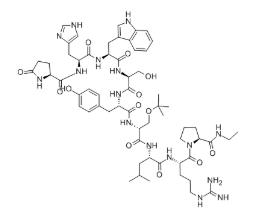Buserelin CAS#: 68630-75-1; ChemWhat Code: 52847
Identification
| Product Name | Buserelin |
| IUPAC Name | acetic acid;(2S)-N-[(2S)-1-[[(2S)-1-[[(2S)-1-[[(2S)-1-[[(2R)-1-[[(2S)-1-[[(2S)-5-(diaminomethylideneamino)-1-[(2S)-2-(ethylcarbamoyl)pyrrolidin-1-yl]-1-oxopentan-2-yl]amino]-4-methyl-1-oxopentan-2-yl]amino]-3-[(2-methylpropan-2-yl)oxy]-1-oxopropan-2-yl]amino]-3-(4-hydroxyphenyl)-1-oxopropan-2-yl]amino]-3-hydroxy-1-oxopropan-2-yl]amino]-3-(1H-indol-3-yl)-1-oxopropan-2-yl]amino]-3-(1H-imidazol-5-yl)-1-oxopropan-2-yl]-5-oxopyrrolidine-2-carboxamide |
| Molecular Structure |  |
| CAS Registry Number | 68630-75-1 |
| EINECS Number | 261-061-9 |
| MDL Number | MFCD00941414 |
| Beilstein Registry Number | No data available |
| Synonyms | buserelin acetate |
| Molecular Formula | C62H90N16O15 |
| Molecular Weight | 1299.47 |
| InChI | InChI=1S/C60H86N16O13.C2H4O2/c1-7-64-57(87)48-15-11-23-76(48)58(88)41(14-10-22-65-59(61)62)69-51(81)42(24-33(2)3)70-56(86)47(31-89-60(4,5)6)75-52(82)43(25-34-16-18-37(78)19-17-34)71-55(85)46(30-77)74-53(83)44(26-35-28-66-39-13-9-8-12-38(35)39)72-54(84)45(27-36-29-63-32-67-36)73-50(80)40-20-21-49(79)68-40;1-2(3)4/h8-9,12-13,16-19,28-29,32-33,40-48,66,77-78H,7,10-11,14-15,20-27,30-31H2,1-6H3,(H,63,67)(H,64,87)(H,68,79)(H,69,81)(H,70,86)(H,71,85)(H,72,84)(H,73,80)(H,74,83)(H,75,82)(H4,61,62,65);1H3,(H,3,4)/t40-,41-,42-,43-,44-,45-,46-,47+,48-;/m0./s1 |
| InChI Key | PYMDEDHDQYLBRT-DRIHCAFSSA-N |
| Canonical SMILES | CCNC(=O)C1CCCN1C(=O)C(CCCN=C(N)N)NC(=O)C(CC(C)C)NC(=O)C(COC(C)(C)C)NC(=O)C(CC2=CC=C(C=C2)O)NC(=O)C(CO)NC(=O)C(CC3=CNC4=CC=CC=C43)NC(=O)C(CC5=CN=CN5)NC(=O)C6CCC(=O)N6.CC(=O)O |
| Patent Information |
| No data available |
Physical Data
| Appearance | White or slightly yellowish powder |
| Solubility | No data available |
| Melting Point | 186-188°C |
| Refractive index | No data available |
| Sensitivity | No data available |
Spectra
| No data available |
Route of Synthesis (ROS)
| No data available |
Safety and Hazards
| Pictogram(s) |   |
| Signal | Danger |
| GHS Hazard Statements | H302 (66.67%): Harmful if swallowed [Warning Acute toxicity, oral] H360 (100%): May damage fertility or the unborn child [Danger Reproductive toxicity] Information may vary between notifications depending on impurities, additives, and other factors. |
| Precautionary Statement Codes | P201, P202, P264, P270, P281, P301+P312, P308+P313, P330, P405, and P501 (The corresponding statement to each P-code can be found at the GHS Classification page.) For more detailed information, please visit ECHA C&L website |
| Source: European Chemicals Agency (ECHA) License Note: Use of the information, documents and data from the ECHA website is subject to the terms and conditions of this Legal Notice, and subject to other binding limitations provided for under applicable law, the information, documents and data made available on the ECHA website may be reproduced, distributed and/or used, totally or in part, for non-commercial purposes provided that ECHA is acknowledged as the source: “Source: European Chemicals Agency, http://echa.europa.eu/”. Such acknowledgement must be included in each copy of the material. ECHA permits and encourages organisations and individuals to create links to the ECHA website under the following cumulative conditions: Links can only be made to webpages that provide a link to the Legal Notice page. License URL: https://echa.europa.eu/web/guest/legal-notice Record Name: (1-Cyano-2-ethoxy-2-oxoethylidenaminooxy)dimethylamino-morpholino-carbenium hexafluorophosphate URL: https://echa.europa.eu/information-on-chemicals/cl-inventory-database/-/discli/details/213446 Description: The information provided here is aggregated from the “Notified classification and labelling” from ECHA’s C&L Inventory. Read more: https://echa.europa.eu/information-on-chemicals/cl-inventory-database |
Other Data
| Transportation | NONH for all modes of transport |
| Under the room temperature and away from light | |
| HS Code | No data available |
| Storage | Under the room temperature and away from light |
| Shelf Life | 1 year |
| Market Price | USD |
| Druglikeness | |
| Lipinski rules component | |
| Molecular Weight | 1299.49 |
| HBA | 30 |
| HBD | 16 |
| Matching Lipinski Rules | 0 |
| Veber rules component | |
| Polar Surface Area (PSA) | 478.07 |
| Rotatable Bond (RotB) | 42 |
| Matching Veber Rules | 0 |
| Use Pattern |
| Buserelin CAS#: 68630-75-1 can increase the secretion of Luteinizing Hormone, Follicle Stimulating Hormone and sex hormones |
| Buserelin CAS#: 68630-75-1 used to treat prostate cancer, breast cancer, endometriosis, uterine fibroids and other diseases. |
| Buserelin CAS#: 68630-75-1 can also be used to make nasal sprays. |
Buy Reagent | |
| No reagent supplier? | Send quick inquiry to ChemWhat |
| Want to be listed here as a reagent supplier? (Paid service) | Click here to contact ChemWhat |
Approved Manufacturers | |
| Apnoke Scientific Ltd | http://www.apnoke.com/ |
| Want to be listed as an approved manufacturer (Requires approvement)? | Please download and fill out this form and send back to approved-manufacturers@chemwhat.com |
Contact Us for Other Help | |
| Contact us for other information or services | Click here to contact ChemWhat |
